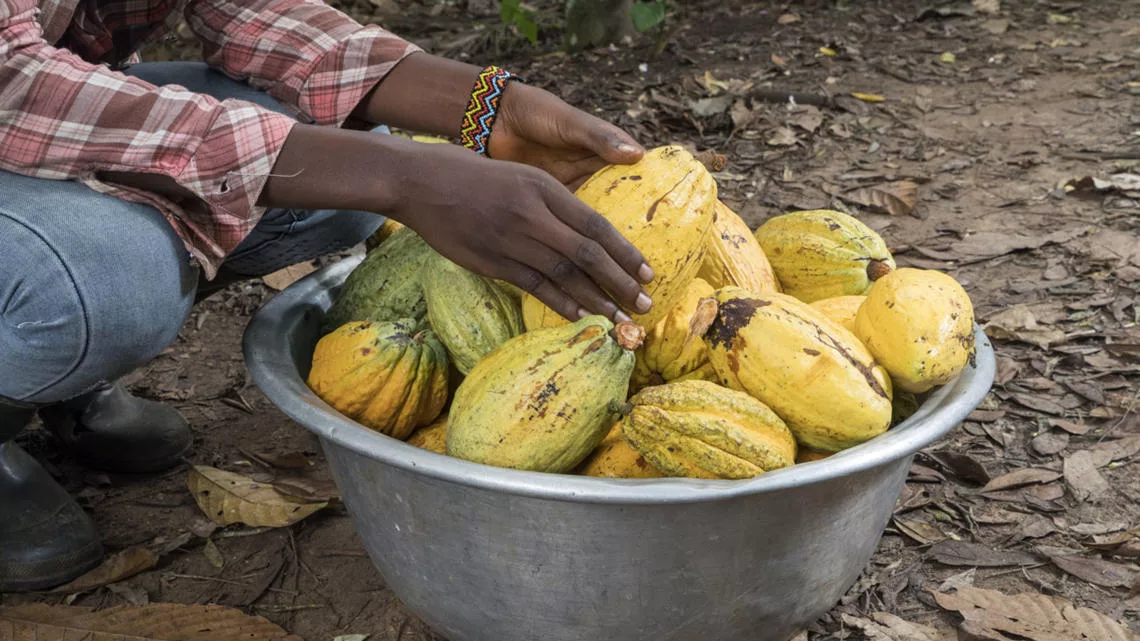Nestlé and the just transition
Nestlé is the world’s largest publicly held food and beverage company. Headquartered in Switzerland, it operates in 186 countries, and employs over 270,000 people.1
Nestlé’s brand and product range is extensive – with over 2000 food and beverage brands and seven product categories including coffee, pet-care, prepared dishes, milk products and ice cream, and confectionary. As such, Nestlé is a key market player in multiple agricultural value chains around the world. It works with over 500,000 farmers worldwide.
Its stated purpose is ‘Unlocking the power of food to enhance quality of life for everyone, today and for generations to come.’ To live up to its purpose Nestlé is undertaking a range of actions, in support of its publicly stated health, sustainability, and human rights targets, including:
For the planet: to strive for net zero greenhouse gas emissions across its value chains by 2050 at the latest.
For communities: to aim for 100% of key raw material volumes to be produced sustainably by 2030 through achieving a resilient food supply chain where growers are protected.
People and respect for human rights are at the core of Nestlé’s sustainability and net zero mission. The company has a particular focus on supporting a just transition for farmers in its supply chains, who are often the most vulnerable and exposed to the risks and damages caused by climate change.
“We have the size, scale and reach to inspire others and help drive collective action. We are focused on transforming farming practices at the heart of the food system while enabling a just and equitable transition.” – Owen Bethell, Environmental Impact Lead, Global Public Affairs
Child labor in cocoa production is a longstanding and complex challenge, where Nestlé is leading the way on policy solutions, while tackling climate change at the same time.
As one of the top 10 chocolate companies in the world, Nestlé is heavily reliant upon cocoa as a key input to chocolate production. Cocoa is a commodity upon which more than 20 million people directly depend for their livelihoods, with 60% of the world’s cocoa produced in Côte d’Ivoire and Ghana.2
Problems with the widespread use of child labor in cocoa production in these countries are longstanding and well documented. During the 2018/19 cocoa-growing season, research commissioned by the U.S Department of Labor found that 1.48 million children in these two countries (43% of all children from agricultural households) were engaged in hazardous work on cocoa farms including working with sharp tools and agricultural chemicals and carrying heavy loads.3
The global chocolate industry, including Nestlé and its competitors, has faced significant criticism about this issue historically. The root causes of child labor in cocoa farming are complex and difficult to address. They include poverty, lack of access to education, and limited awareness about child safety and development needs. While Nestlé fully recognizes that there is still a long way to go, it has been recognized by the 2022 Chocolate Scorecard as leading the industry on policy to address the problems of child labor.
“Tackling child labor risks is a critical part of a just transition to a fairer and more sustainable food system.” – Owen Bethell, Environmental Impact Lead, Global Public Affairs
Nestlé’s approach to tackling child labor
Children deserve the chance to learn, and to grow in a safe and healthy environment. Nestlé is committed to working with its suppliers and local communities to prevent and address child labor risks throughout its supply chains. It seeks to take action on the ground, address the root causes of the problem, and help families reach a living income.

Collaboration and transparency
In West Africa, most child labor in cocoa involves children supporting their parents on farms, so Nestlé prioritizes family and community engagement. Under the Nestlé Cocoa Plan, it helps parents understand the types of tasks that are appropriate for children. Where child labor risks are detected across any of the thousands of households covered by Nestlé’s Child Labor Monitoring and Remediation System, Nestlé engages directly with families and communities to understand the root cause and develop tailored solutions. Nestlé was the first company to implement a system to address child labor risk in its cocoa supply chain. The company made its system to tackle child labor risk available across the industry, and it is now widely used by other cocoa-buying companies.
Given the scale and complexity of human rights challenges around the world, including child labor, Nestlé has also invested in relationships with various organizations to share learnings, cultivate common approaches and create positive impact at scale. This includes working with the Fair Labor Association and The International Labor Organization’s Child Labor Platform.
Impact achieved
Through these and other measures implemented by Nestlé over the last decade, more than 145,000 children have been protected against the risk of child labor since 2012. Nestlé keeps contact with the families of over 86,000 children to assess the risk of child labor.

Community resilience
In January 2022, Nestlé announced its new Income accelerator program; a new plan to tackle child labor risks in cocoa production. At the center is an innovative income accelerator program, which aims to improve the livelihoods of cocoa-farming families, while also advancing regenerative agriculture practices to help mitigate the risks of climate change and promoting gender equality.
Insufficient family income is a key driver of child labor. Nestlé’s program aims to help close the living income gap by providing financial incentives to cocoa farming families for:
- school enrolment – reducing child labor risks by assisting school attendance and monitoring;
- good agricultural practices – Helping farmers improve cocoa production by training and subsidizing pruning groups ;
- agroforestry activities – Improving farm resilience by providing forest and fruit trees; and
- diversifying crops – helping to reduce dependency on cocoa by supporting families to grow other crops or raise livestock.
Additional cash incentives reward families not only for the quantity and quality of cocoa beans they produce but also for the benefits they provide to the environment, the local communities and their children.
Nestlé is currently providing assistance through this program to 10,000 families, with the aim to scale up the program to support an estimated 160,000 families by 2030.
Nestlé’s target for the future
By 2025, Nestlé is committed to being able to trace all cocoa back to a specific group of farms and ensure 100% of the cocoa the company uses is sourced within its sustainability cocoa program.*
*1 Birch, Kate. 2021 Top 10 Largest Chocolate Companies
*2 Fairtrade UK, About cocoa
*3 U.S. Department of Labor. 2020 Child labor in the production of cocoa
Outline
